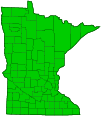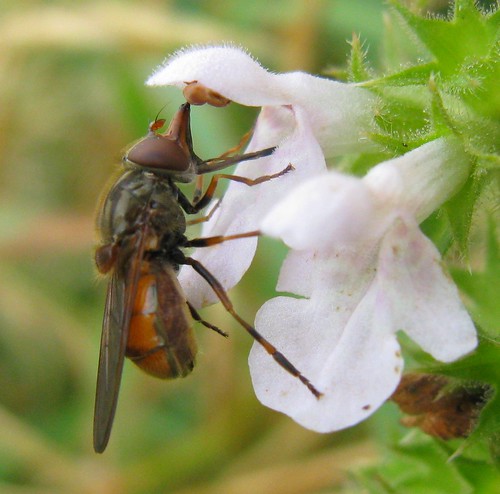marsh hedge nettle
(Stachys palustris)
Conservation • Wetland • Description • Habitat • Ecology • Use • Distribution • Taxonomy
Description |
||
Marsh hedge nettle is a 12″ to 40″ tall, erect, perennial forb that rises from a rhizome. It often forms colonies. The stems are erect, square, hollow, and usually unbranched. They have copious hairs both on the ridges of the stem and between the ridges. The hairs are bent downward. The hairs on the ridges are distinctly longer but not much stouter than those between the ridges. The leaves are opposite, lance egg-shaped or broadly oblong to egg-shaped, 1⅜″ to 3½″ long, and mostly ¾″ to 1½″ wide. They are mostly stalkless but some may be on short leaf stalks. The leaf blades taper to a point at the tip and are broadly rounded or almost heart-shaped at the base. The upper surface is green and hairy. The lower surface is paler green and has hairs along the major veins. The margins have rounded, forward-pointing teeth. The inflorescence is a cluster of usually 6 flowers. Lower clusters rise from the upper leaf axils. Middle and upper clusters are opposite and are subtended by a small, leaf-like bract. Each pair of opposite flower clusters together form a false whorl. The bracts become gradually smaller as they ascend the stem. The flowers are 7 ⁄16″ to ⅝″ long. They have 5 green or purplish, hairy sepals that are fused at the base into a calyx tube ¼″ to ⅜″ long and separated at the end into 5 lance-shaped lobes. The calyx lobes are nearly as long as the calyx tube and are hairy. There are 5 petals that are fused at the base into a corolla tube about ¼″ long. The petals are pink or lavender with white spots. The calyx tube is always at least ⅔ as long as the corolla tube. The corolla is divided at the end into 2 lips. The upper lip is about 3 ⁄16″ long and ⅛″ wide, hood-like, hairy outside, hairless inside. The lower lip is divided at the tip into 3 lobes, a large central lobe and 2 smaller lateral lobes. There are 4 stamens protected beneath the hood. The fruit is 4 greenish-white, 3-ribbed, 1-seeded nutlets. They turn black when they ripen. |
||
Height |
||
12″ to 40″ |
||
Flower Color |
||
Pink or lavender with white spots |
||
Similar Species |
||
American germander (Teucrium canadense) flowers have a greatly reduced upper lip. Hispid hedge nettle (Stachys hispida) stems have hairs on the ridges but no hairs between the ridges. Smooth hedge nettle (Stachys tenuifolia) stems have hairs on the ridges but no hairs between the ridges. The leaves may have hairs along the midribs but are otherwise hairless. Woundwort (Stachys pilosa var. arenicola) stems have hairs on the ridges and between the ridges that are about alike. The leaves are narrower, rarely wider than ¾″. |
||
Habitat |
||
Moist to wet |
||
Ecology |
||
Flowering |
||
July to August |
||
Pests and Diseases |
||
|
||
Use |
||
|
||
Distribution |
||||
|
Sources |
|||
| 5/12/2023 | ||||
Nativity |
||||
Native |
||||
Occurrence |
||||
Common |
||||
Taxonomy |
|||
| Kingdom | Plantae (Plants) | ||
| Subkingdom | Pteridobiotina | ||
| Phylum | Tracheophyta (Vascular Plants) | ||
| Class | Magnoliopsida (Dicots) | ||
Order |
Lamiales (Mints, Plantains, Olives, and Allies) | ||
Family |
Lamiaceae (Mint) | ||
| Subfamily | Lamioideae | ||
| Tribe | Stachydeae | ||
| Genus | Stachys (hedge nettles) | ||
There is considerable disagreement about the number, the classification, and the common names of Minnesota’s Stachys species and varieties. |
|||
Synonyms |
|||
Stachys asperrima Stachys borealis Stachys homotricha Stachys palustris var. homotricha Stachys palustris var. nipigonensis Stachys palustris var. phaneropoda Stachys palustris var. pilosa Stachys palustris ssp. pilosa Stachys palustris var. puberula Stachys scopulorum Stachys teucriifolia Stachys teucriiformis |
|||
Common Names |
|||
hairy hedgenettle hairy hedge-nettle marsh hedge nettle woundwort |
|||
Glossary
Bract
Modified leaf at the base of a flower stalk, flower cluster, or inflorescence.
Calyx
The group of outer floral leaves (sepals) below the petals, occasionally forming a tube.
Corolla
A collective name for all of the petals of a flower.
Linear
Long, straight, and narrow, with more or less parallel sides, like a blade of grass.
Rhizome
A horizontal, usually underground stem. It serves as a reproductive structure, producing roots below and shoots above at the nodes.
Sepal
An outer floral leaf, usually green but sometimes colored, at the base of a flower.
Visitor Photos |
|||||
Share your photo of this plant. |
|||||
| This button not working for you? Simply email us at info@MinnesotaSeasons.com. Attach one or more photos and, if you like, a caption. |
|||||
Luciearl |
|||||
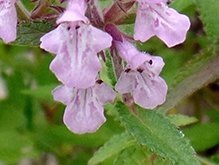 |
|||||
MinnesotaSeasons.com Photos |
|||||
Plant |
|||||
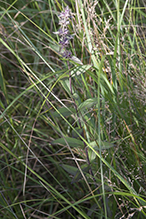 |
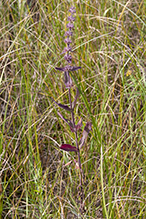 |
||||
Leaves |
|||||
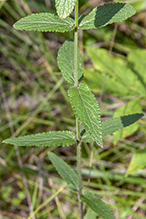 |
|||||
Infructescence |
|||||
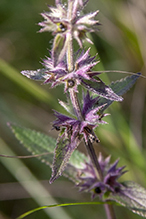 |
|||||

Visitor Videos |
|||
Share your video of this plant. |
|||
| This button not working for you? Simply email us at info@MinnesotaSeasons.com. Attach a video, a YouTube link, or a cloud storage link. |
|||
Other Videos |
|||
| Moerasandoorn Stachys palustris 5 juli 2010.wmv Wim Derks |
|||
About
Uploaded on Jul 5, 2010 Van dichtbij een bloem waarvan het bijna exotische doet denken aan orchideeën. Langs onze sloten en op andere vochtige gronden is zij heel algemeen. |
|||

Visitor Sightings |
|||||
Report a sighting of this plant. |
|||||
| This button not working for you? Simply email us at info@MinnesotaSeasons.com. Be sure to include a location. |
|||||
| Luciearl 8/29/2019 |
Location: Lake Shore |
 |
|||
MinnesotaSeasons.com Sightings |
|||||

|
Created: Last Updated: © MinnesotaSeasons.com. All rights reserved. |
